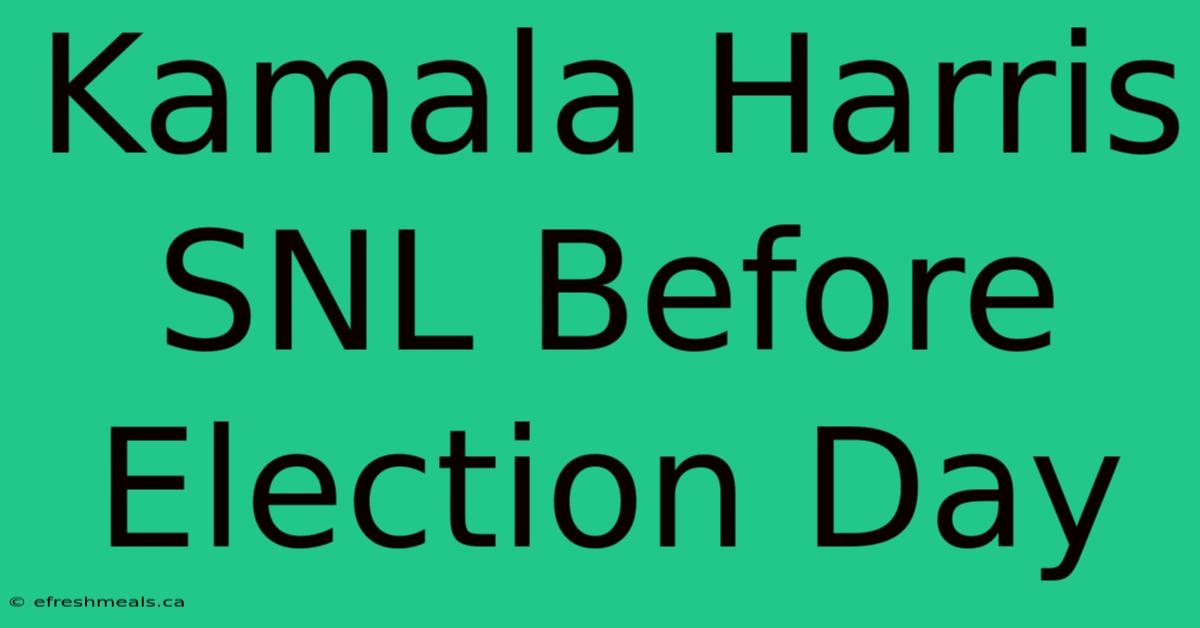Kamala Harris SNL Before Election Day

Discover more detailed and exciting information on our website. Click the link below to start your adventure: Visit Best Website nimila.me. Don't miss out!
Table of Contents
Kamala Harris' SNL Appearance: A Historic Moment Before Election Day
Did Kamala Harris' appearance on Saturday Night Live impact the 2020 election? While we can't definitively say, her performance on the show just weeks before Election Day certainly made headlines and sparked conversation.
Why It Matters: This was a historic moment. Harris became the first female vice presidential candidate to host SNL in the show's long history. Her appearance was not only a significant event in the world of comedy and politics but also an opportunity to connect with voters in a lighthearted, relatable way.
Key Takeaways of Kamala Harris on SNL:
| Takeaway | Description |
|---|---|
| Political Satire: Harris embraced satire, poking fun at herself and the campaign trail. | |
| Humor & Charisma: Her performance showcased her comedic timing and personal charisma. | |
| Media Attention: The appearance generated widespread media attention, further amplifying the campaign's message. |
Kamala Harris on SNL
Significance: Harris' appearance on SNL was groundbreaking for a number of reasons. Firstly, it broke new ground in terms of female representation in political comedy. Secondly, it provided a platform for her to connect with a younger, more diverse audience – a key demographic in the 2020 election.
Key Aspects:
- Sketches: Harris participated in a range of sketches, including a parody of the Running Mate game show where she joked about her policy positions.
- Monologue: Her opening monologue addressed the challenges of the campaign trail and her vision for the future.
- Musical Performance: Harris joined musical guest Jack Harlow on stage, showcasing her sense of humor and her ability to adapt to unexpected situations.
Impact:
The impact of Harris' SNL appearance is difficult to quantify definitively. However, it undoubtedly generated significant buzz, increased her name recognition, and provided a unique platform to engage with voters.
Humor and Politics:
Harris' willingness to engage in humor and self-deprecation on SNL reflected a growing trend in politics, where candidates are seeking to connect with voters on a more personal and relatable level. The use of humor can be a powerful tool in bridging political divides and making complex issues more accessible.
Further Analysis:
Some critics argued that Harris' SNL appearance was too lighthearted, suggesting that it may have downplayed the seriousness of the election. Others argued that it was a refreshing change of pace, a moment of levity in a heated and divisive political climate. Ultimately, Harris' performance on SNL is a testament to the evolving nature of politics and the ways in which candidates are using creative platforms to connect with voters.
FAQ:
| Question | Answer |
|---|---|
| Did Kamala Harris write her own SNL monologue? | While the monologue was likely a collaborative effort, Harris was heavily involved in the writing process. |
| What was the overall reception to Kamala Harris' SNL performance? | Reactions were generally positive, with many praising her comedic timing and her ability to connect with the audience. |
| Was Kamala Harris' SNL appearance a political strategy? | While the appearance served as a platform to connect with voters, it was also a way to humanize Harris and showcase her personality. |
Tips for Election Campaigns:
- Embrace Humor: Use humor to connect with voters on a personal level.
- Use Creative Platforms: Explore new and innovative ways to reach your audience.
- Emphasize Personal Stories: Share your personal experiences and connect with voters on an emotional level.
Summary:
Kamala Harris' appearance on Saturday Night Live was a historic moment that helped her connect with voters, showcase her personality, and contribute to the ongoing evolution of political communication. While its impact on the election remains debated, her performance undoubtedly generated significant attention and conversation.
Closing Message: As campaigns continue to explore new and innovative ways to engage with voters, Kamala Harris' SNL performance stands as a reminder of the power of humor and creativity in shaping political narratives. It also highlights the evolving nature of political communication in the digital age.

Thank you for visiting our website wich cover about Kamala Harris SNL Before Election Day. We hope the information provided has been useful to you. Feel free to contact us if you have any questions or need further assistance. See you next time and dont miss to bookmark.
Featured Posts
-
Napoli Faces Atalanta In Title Race
Nov 04, 2024
-
Apple Vision Pro Uae Launch November 15
Nov 04, 2024
-
Apple Vision Pro New Markets Open
Nov 04, 2024
-
Damage Assessment Oklahoma City Storm
Nov 04, 2024
-
Jets Vs Kraken
Nov 04, 2024
